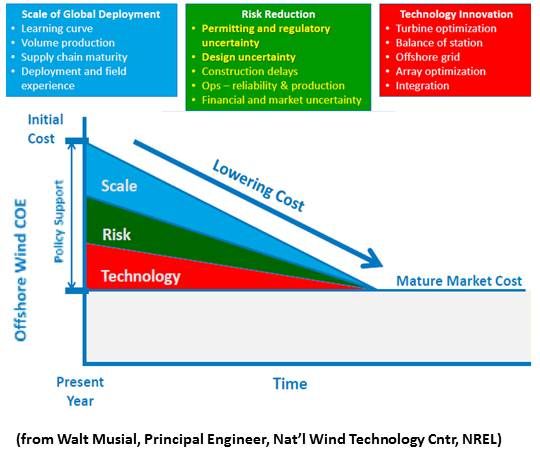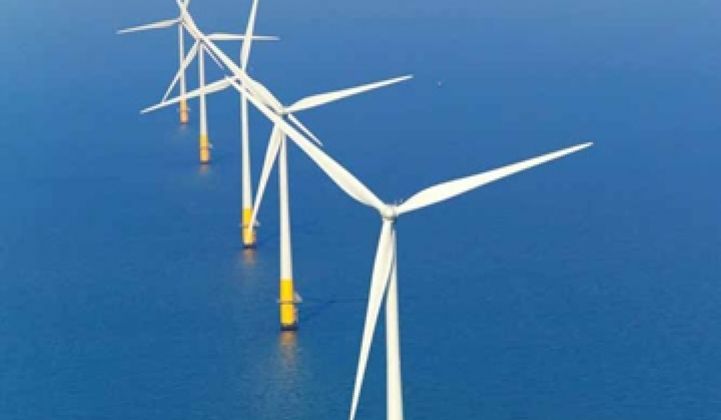The wind industry appears to be getting its mojo back after the funk that preceded the Jan. 1 extension of the federal production tax credit (PTC).
Broadwind Energy (BWEN), one of the leading U.S. turbine tower manufacturers, just announced a $14 million order for delivery in 2H 2013. That follows announcements of a $35 million order in March and a $27 million order in February.
“We are quoting orders for 2014 delivery as the wind energy industry recovers from the downturn at the end of 2012,” Broadwind President and CEO Peter C. Duprey recently reported.
Another indicator: E.ON Climate & Renewables (EC&R) North America recently secured $174.9 million in equity financing for its 200-megawatt Wildcat 1 Wind Farm in Indiana from a group of investors that included J.P. Morgan’s JPM Capital and Wells Fargo Wind Holdings.
“Nobody knew last year whether or not we were going to have a PTC this year,” a top equity finance banking executive recently told GTM, “so all those negotiations pretty much came to a halt and were suspended. Now all that is picking back up again.”
Utilities continue to seek more wind -- especially those, like Xcel Energy (NYSE:XEL), that have a more in-depth understanding of its value. Xcel Energy, which got a record 33 percent of its Upper Midwest system’s electricity from wind on February 17. Xcel just issued an “all-source” request for proposals (RFP) for Colorado that includes a fast-track process for wind projects.
Xcel would begin negotiating wind power purchase agreements (PPAs) around mid-June and will make final selections by October 9, allowing developers to begin building in time to qualify for the PTC under its new “in construction” provision.
"Utilities are very smart,” the banking executive said. “They realize they need a mix of sources.” Natural gas is cheap now, but utilities don’t know how long that will last, he added. Wind allows them to lock in a fixed price over a long term.

One thing that is a little different this year that has been very helpful in financing renewables is that a number of banks, through their commodity trading businesses, have offered fixed-price, long-term commodity hedges for wind power, GTM’s source pointed out. Such hedges allow tax equity investors to participate in a project that does not have a traditional PPA.
Tax equity investors and banks don’t like too much price volatility, he said. Without a fixed price that has been contracted for in a PPA, a generator is subject to the daily power industry market price swings. “That makes a deal difficult if not impossible to finance,” he explained. A commodity hedge is a financial instrument that trades the daily market variable price for a pre-agreed fixed price for ten to fifteen years. That can eliminate the price volatility associated with a project and has allowed wind farms to get built that probably would not have otherwise.
A hedge’s ten-year term suits tax equity investors, the bank exec said, because such financings are generally looking at a ten-year term that matches the term of the PTC.
Hedges could play a much bigger role in wind (and utility-scale solar) until policymakers push through the new financial instruments like Master Limited Partnerships, Real Estate Investment Trusts, and securitizations that are now under scrutiny.
The emergence of the hedge strategy could even attract institutional capital investors that are not interested in tax equity if the PTC phases out.
But don’t count on that phase-out occurring too soon. AWEA was backed into the phase-out talk by some of the politicians on the hill, wind industry sources have told GTM, but it was offered in the expectation there would be broad tax reform.
Most Washington watchers agree that broad tax reform is a mirage. What that means for a PTC phase-out remains to be seen.

One last sign that the U.S. wind industry is on the verge of big new things: the Bank of Tokyo-Mitsubishi UFJ (NYSE:MTU) signed up as commercial bank debt financing lead for Cape Wind, which is on the verge of becoming the first U.S. offshore wind project in go into construction.
The Bank will also provide a significant amount of commercial bank debt capital to develop and construct the now fully permitted 468-megawatt project to be built in Nantucket Sound off Cape Cod.



